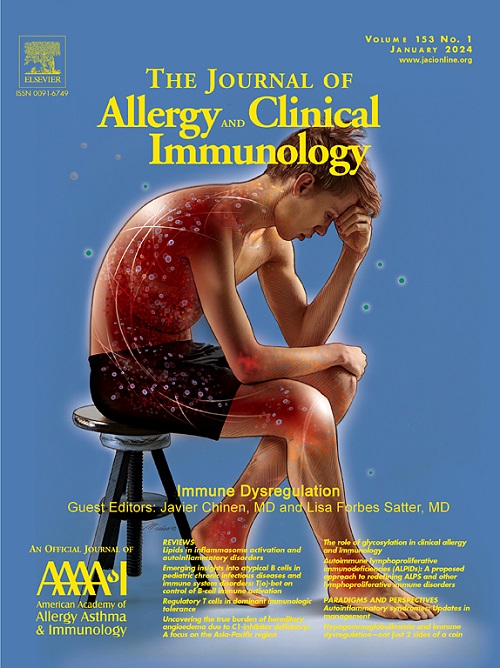代谢型与不受控制的儿童哮喘、肠道微生物群和全身性炎症有关。
IF 11.4
1区 医学
Q1 ALLERGY
引用次数: 0
摘要
儿童哮喘与不同的代谢组学特征有关。目的通过综合粪便和血清代谢组学分析,确定中重度哮喘患儿的表型(代谢型)。方法从系统药理学方法纳入全球哮喘治疗计划步骤≥3的非受控儿童哮喘队列。哮喘控制通过哮喘控制试验和年度加重史来定义。采用液相色谱和流动注射电喷雾电离-三重四极杆质谱法对粪便和血清进行靶向代谢组学分析。相似网络融合整合粪便和血清代谢谱,然后进行光谱聚类。分析各组哮喘特征、饮食日记、粪便微生物群组成、血清炎症标志物和血细胞水平的差异。结果92例中重度哮喘患儿(中位年龄:11.5岁,女性占34%)的粪便和血清代谢组学综合分析显示出三种代谢类型。代谢型1的变应性鼻炎比例最低,血清神经酰胺和甘油三酯升高。代谢型2具有较高的哮喘控制几率,母乳喂养≥4个月的儿童比例最高,糖摄入量减少,血液中性粒细胞和血清炎症标志物水平最低,血清酰基肉碱和ω-3脂肪酸水平升高。代谢类型3包括最高比例的未控制哮喘患者,血清胆固醇酯、磷脂酰胆碱和鞘磷脂降低,粪便氨基酸升高,粪便微生物群多样性减少。结论:中重度哮喘患儿的代谢型与哮喘控制、不同的粪便微生物群和全身炎症模式有关。研究结果表明,代谢分型在哮喘的精准医学方法中是有价值的。本文章由计算机程序翻译,如有差异,请以英文原文为准。
Metabotypes are linked to uncontrolled childhood asthma, gut microbiota, and systemic inflammation.
BACKGROUND
Childhood asthma has been linked to distinct metabolomic profiles.
OBJECTIVE
To identify phenotypes (metabotypes) in children with moderate-to-severe asthma through integrative fecal and serum metabolome analysis.
METHODS
Children from the Systems Pharmacology Approach to Uncontrolled Pediatric Asthma cohort with Global Initiative for Asthma treatment step ≥3 were recruited. Asthma control was defined by the Asthma Control Test and annual exacerbation history. Targeted metabolomics profiling of feces and serum was performed using liquid chromatography and flow injection electrospray ionization-triple quadrupole mass spectrometry. Similarity Network Fusion integrated fecal and serum metabolome profiles, followed by spectral clustering. Clusters were analyzed for differences in asthma characteristics, food diaries, fecal microbiota composition, and levels of serum inflammatory markers and blood cells.
RESULTS
Integrative fecal and serum metabolome analysis of 92 children with moderate-to-severe asthma (median age: 11.5 years, 34% female) revealed three metabotypes. Metabotype1 had the lowest percentage of allergic rhinitis, with elevated serum ceramides and triglycerides. Metabotype2 had higher odds of asthma control, the highest percentage of children with ≥4 months of breastfeeding, reduced sugar intake, lowest levels of blood neutrophils and serum inflammatory markers, and with elevated serum acylcarnitines and ω-3 fatty acids. Metabotype3 included the highest percentage of uncontrolled asthma patients, with decreased serum cholesteryl esters, phosphatidylcholines, and sphingomyelins, elevated fecal amino acids, and reduced fecal microbiota diversity.
CONCLUSIONS
Metabotypes in children with moderate-to-severe asthma are linked to asthma control, distinct fecal microbiota and systemic inflammatory patterns. The findings suggest that metabotyping can be valuable in precision medicine approaches for asthma.
求助全文
通过发布文献求助,成功后即可免费获取论文全文。
去求助
来源期刊
CiteScore
25.90
自引率
7.70%
发文量
1302
审稿时长
38 days
期刊介绍:
The Journal of Allergy and Clinical Immunology is a prestigious publication that features groundbreaking research in the fields of Allergy, Asthma, and Immunology. This influential journal publishes high-impact research papers that explore various topics, including asthma, food allergy, allergic rhinitis, atopic dermatitis, primary immune deficiencies, occupational and environmental allergy, and other allergic and immunologic diseases. The articles not only report on clinical trials and mechanistic studies but also provide insights into novel therapies, underlying mechanisms, and important discoveries that contribute to our understanding of these diseases. By sharing this valuable information, the journal aims to enhance the diagnosis and management of patients in the future.

 求助内容:
求助内容: 应助结果提醒方式:
应助结果提醒方式:


